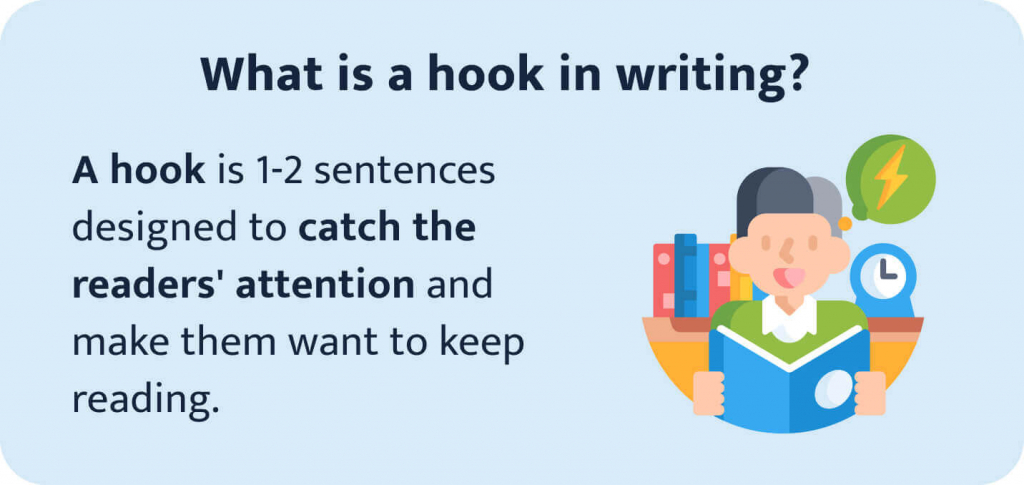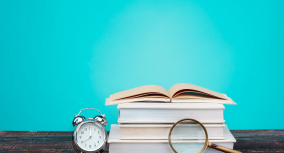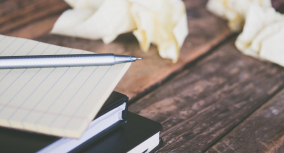A catchy hook— a compelling opening line that seizes the reader’s interest right away — is the most effective way to make your essay memorable from the start. Usually situated in the beginning of the introductory paragraph, a well-chosen hook sentence impresses the audience immediately, motivating them to keep reading.
But what are good hooks that captivate readers?
Well, that depends on your topic, genre, and audience. There are many types of hooks in writing, including questions, facts, quotes, personal stories, and anecdotes.
Want to know more? Read on! In this article, Custom-Writing.org experts explain what the hook in writing is, what good hooks are, and how to craft a catchy one based on your goals and needs. Plus, we’ve included some great hook examples for inspiration!
🪝 Hook Definition
A hook in writing is a catchy opening sentence that makes the reader want to keep reading. It is also called an attention-getter or a lead.

In essays, a hook is usually found in the first sentence of the introduction. A good lead makes the readers impressed from the get-go, which raises your chance of getting a good grade.
“Hook the Reader”: What Does It Mean?
Hundreds of different essays cover the same topic. So why should the professor prefer your paper over others? It’s because you’ve made them curious from the very beginning.
It’s similar to fishing: you need to use a hook if you want to catch fish. You can also compare a text to music in terms of catchiness. When a song has a great hook, it grabs your attention, and you keep listening to it.
What Makes a Good Hook
Sure, you want your attention-getter to be catchy, but how can you tell if it’s good enough? To help you with this task, we have prepared a checklist:
Hook and Thesis: Difference
A hook is a vital part of an introduction. Although some people may confuse it with a thesis statement, these are two different things:
- A hook gets the reader’s attention.
- A thesis statement presents the text’s central idea.
When you have both the hook and the thesis statement, you need to link them together. The sentence that connects them is called a transition.
📚 Types of Hooks for Essays
When it comes to hooks, there are many options you can choose from. Keep reading and learn about different types of attention-getters.
Using Questions in Essays as Hooks
Do you know how to put a question in an essay? In fact, it can make a very effective hook. When you see an interesting question, you want to find out the answer. And this is exactly what we need to grab attention.
There are two types of questions you can use for the hook:
- Open-ended questions. You want to make the readers think about it. When the question has a simple yes-or-no answer, the interest fades very quickly. In contrast, when the question requires thinking, the readers become way more interested.
Example:
What is the difference between a child and an adult?
- Rhetorical questions. Such questions either have obvious answers or don’t require any at all. They make people think creatively. However, they are not suitable for academic writing, where you’re supposed to provide answers to all the questions you’ve asked.
Example:
Is there a remedy for widespread poverty and hunger?
When choosing a question, make sure to connect it to the topic of your essay.
Using a Quote as a Hook
Starting a paper with a quote is a fantastic way to hook a reader. It’s especially suitable for literature essays. For example, the quote “If love be blind, love cannot hit the mark” can be a perfect hook for Romeo and Juliet essay.
Sometimes it’s hard to find a suitable quote. But once you do that, your introduction starts to sound exciting and credible. Just make sure to take quotations from reliable sources.
Now, let’s see how to use quotations as hooks:
- Find a quote connected with your topic. You already know that the attention-getter should lead the reader to the essay’s theme. So make sure that that the quote is related to the topic.
- Use the correct format. Remember that each writing style requires different formatting of quotes. Check out the article by Columbia College to learn more about introducing quotations properly.
- Explain the quote’s significance. Sometimes, the connection between the quote and the topic might be unclear. If that’s the case, make sure to explain it to the readers.
Narrative Hook: Definition & Example
The narrative hook is a device that authors use to engage people to read their stories. Essentially, this technique aims to show why the story is worth reading. It’s usually found in literature, but it also can be used for creative writing.
Here is how to make people want to read your narrative essay:
- Make the readers intrigued. Try starting with a sentence that instantly provokes curiosity. This way, you’ll make the reader want to know what happens at the end.
- Make the readers visualize. Using vivid descriptions will immerse the readers in your story. It will help them feel connected to it, and they will be interested in what happens next.
Example:
I knew that what I did was a big mistake from the very beginning.
Anecdote Hook Examples
In anecdotes, you tell people about your experiences connected with a particular topic. Usually, such stories are taken from personal life. Compared to other types of hooks, anecdote hooks may be slightly longer.
Anecdote hooks are pretty similar to narrative ones. Both are used to make people feel connected to the story. Keep in mind that none of these 2 types are used in academic essays; however, they are perfect for creative writing.
The key to the success of using this kind of hook is to make the story universally relatable. It doesn’t have to be just about you. Try to formulate it in such a way that the majority of people would be able to understand it.
Below you can see a story hook example:
Example:
When I moved to another country, I have experienced a considerable culture shock. Have you ever felt complete helplessness? This is how I felt for a long time.
Hooks for Informational Writing
Informational writing is used to explain or to inform the reader about something. It includes articles, reports, and biographies. When it comes to hooks for informational writing, there are two options you can choose from:
- Interesting facts. Before you start elaborating on your topic, present the reader with a simple yet surprising fact. It will surely grab their attention and spark their interest. While researching your topic, you are likely to come across various interesting facts. So, why not try using one of them?
Example:
The lowest temperature recorded on Earth was -144 degrees Fahrenheit.
- Statistics. People tend to trust numbers. Providing accurate statistics will make a perfect hook because it instantly makes your essay more trustworthy. While doing your research, pay attention to the statistics that surprise you the most.
Example:
Research shows that a third of Americans don’t get enough sleep.
Personal Statement Hooks & College Essay Hooks
A personal statement is an essay that answers the question of who you are. It helps to demonstrate your personality and skills. That’s why it’s one of the tasks college committees require from the applicants.
There are likely hundreds of people eager to study at the same university as you. So, the committee would go through everyone’s personal statements and decide who gets accepted. That is why you need to make it outstanding from the very first line.
- For a college essay, the most suitable attention grabber is a descriptive hook. It helps the readers feel as though they are personally observing what is happening. It’s best to provide them with as many details as possible.
Example:
At school, I didn’t have lazy days. Whether it was too hot or freezing cold outside, I had to go somewhere and do something.
- As for personal statements, you can use quotes, questions, and narrative hooks.
Hooks for Research Papers
When it comes to research papers, a hook is an essential part of the introduction. You can use facts, statistics, or quotes connected with the topic to grab the reader’s attention. You can even start with a joke or an anecdote, but first, you need to make sure it is appropriate.
There is one thing that’s better to avoid at the beginning of research papers. Don’t start with telling people what your research is about because:
- They already know it from the title.
- Your paper may sound monotonous from the very beginning.
Your task is to make the readers interested first and then tell them what they can expect from the text.
Example:
Approximately 85% of people in the U.S. drink at least 1 cup of coffee every day.
Good Hooks for Speeches with Examples
Hooks are essential not only in writing but also during speeches and presentations. Imagine having an audience where everyone is either talking or thinking about something unrelated. The beginning of your speech should catch their attention straight away. Otherwise, they might get bored and stop listening to you.
In this case, try to be as creative as possible with the speech hooks. Say something that will surprise your listeners. It’s good to start with anything they didn’t expect or know before.
Example:
Is there a bright future for our society in the age of consumerism?
Presentations work the same way. You provide people with information, but unlike speeches, here you can also use visuals. Hooks that are suitable for speeches are also acceptable for presentations. Moreover, you can use a picture or a video with your attention-getter. It’s helpful because people tend to like visual aids.
✍️ How to Write a Catchy Hook: Techniques
Now that you know about hooks for different types of essays, let’s find out how to write them. Follow these 3 steps to come up with a perfect attention-getter.
STEP #1. Brainstorm.
Before you start writing, do the following:
- Analyze the topic and the type of essay that you’re working on.
- Think of the most exciting things that you have learned while researching.
- Write down a few ideas that are suitable for the hook.
STEP #2. Think of your audience.
It’s a crucial part. Students and professors may not always agree on what’s interesting or funny. At this point, you can cross out the options that are not good enough for your audience.
STEP #3. Combine the hook, the transition sentence, and the thesis statement.
Try to put everything together and see if it sounds coherent. Here you can see which of your hook ideas fits the best.
Example:
5,1 % of adults in the USA are engaged in heavy drinking. The number is relatively high, considering possible consequences. Regular consumption of alcohol can cause heart disease, weight gain, and high blood pressure.
We hope you have found this article helpful. If you did, don’t forget to share it with your friends. Thank you for reading, and good luck with your essays!
Further reading:
- How to Write a Good Introduction: Examples & Tips [2026 Upd.]
- Effective Academic Writing: Resources & Rules
- 35 Effective Writing Strategies for College Level
- College Essay Writing 101—the Comprehensive Guide [2026]
- A Complete Guide to Essay Writing—Make it Simple
🔍 References:
- How to Write a Hook Masterfully: Grammarly
- Guide to Writing Introductions and Conclusions: Gallaudet University
- How to Write a Hook: East Stroudsburg University
- How to Engage the Reader in a Story Opening: BBC
- The Personal Touch: Using Anecdotes to Hook a Reader: Chronicle
- Writing an Introductory Paragraph: Arkansas State University
- How to Write the Hook of an Essay: ThoughtCo
- Speeches: University of North Carolina at Chapel Hill
- Speech Introductions: University of Nevada
![Critical Analysis Essay Example & Writing Guide [2026]](https://custom-writing.org/blog/wp-content/uploads/2021/10/business-men-sitting-lawyers-s-desk-people-signing-important-documents-284x153.jpg)





![Critical Writing: Examples & Brilliant Tips [2026]](https://custom-writing.org/blog/wp-content/uploads/2021/02/fingers-note-report-journalist-filling-284x153.jpg)




